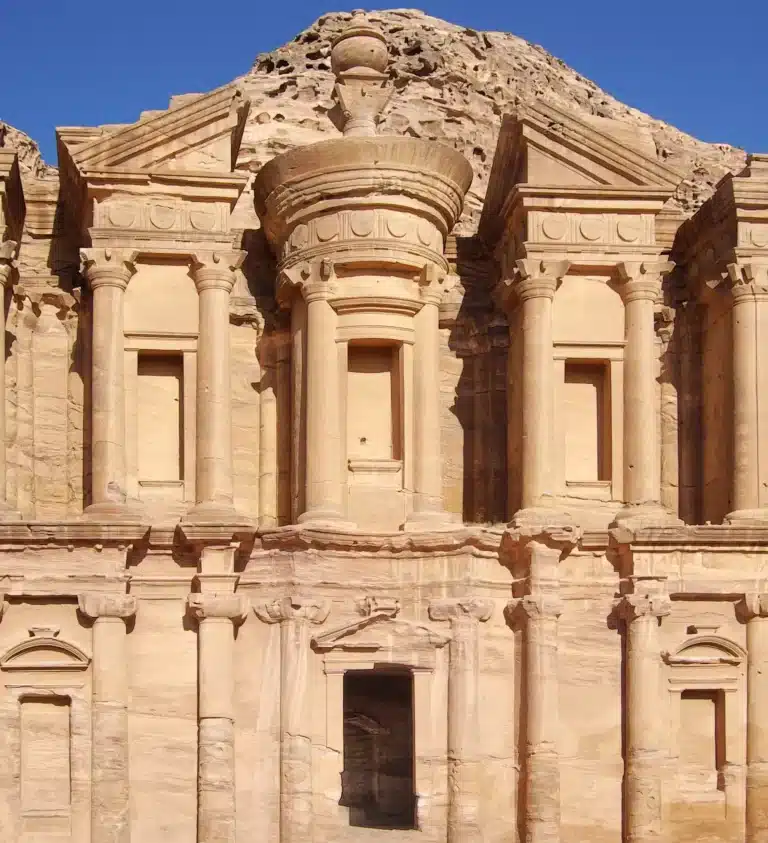
Petra, an ancient city renowned for its architectural splendor and historical significance, nestles within Jordan’s southwestern desert. Its etymology, derived from the Greek word “πέτρα” (petra), means ‘rock’ – a fitting descriptor for a city carved into rose-red sandstone cliffs. Founded by the Nabataeans, an industrious Arab people, Petra flourished from around the 4th century BCE as a vital trade hub, connecting the silk and spice routes from the East to the West.
This archaeological gem, hidden amidst rugged mountains, provided a strategic advantage in defense and trade. The Nabataeans, skilled in water management, harnessed the desert’s scarce resources, creating an oasis of agricultural abundance and urban sophistication. The amalgamation of Hellenistic architectural styles with Eastern traditions fashioned a unique cultural blend, visible in its tombs, temples, and dwellings.
Petra’s prominence dwindled following Roman annexation and subsequent shifts in trade routes. However, its rediscovery in 1812 by Swiss explorer Johann Ludwig Burckhardt revived interest in its historical and cultural significance. Today, Petra is a UNESCO World Heritage Site, attracting scholars and tourists alike, mesmerized by its enduring legacy.
Architectural Brilliance of Petra
Petra’s architecture, a testament to human ingenuity, reflects the Nabataeans’ mastery of their environment. The city’s most iconic structure, Al-Khazneh (The Treasury), stands as a sentinel at the end of a narrow, winding gorge called the Siq. This façade, carved directly into the pink sandstone, showcases a blend of Greek, Roman, and native influences, symbolizing the city’s role as a cultural melting pot.
Beyond Al-Khazneh, Petra unfolds into a sprawling city of tombs, temples, and an amphitheater, all carved with precision into the cliffs. The Monastery, another monumental structure, sits atop a mountain, offering panoramic views of the surrounding valleys. The advanced water management system, consisting of dams, cisterns, and water channels, highlights the Nabataeans’ engineering prowess, ensuring the city’s survival in the arid desert.
Interestingly, Petra finds mention in the Bible, specifically in 2 Kings 14:7 and Isaiah 16:1, as a region called “Sela,” meaning rock. This biblical reference underscores Petra’s historical importance and cultural significance throughout the ages.
Petra’s architectural marvels are not merely artistic achievements but also reflections of a society adept in harmonizing with their environment, creating a legacy that continues to inspire and fascinate.
Cultural and Religious Significance
The cultural landscape of Petra transcends its architectural grandeur. It served as a melting pot of various cultures, including Nabataean, Greek, Roman, and later Byzantine. This convergence is evident in the city’s art, language, and religious practices. Petra’s temples, such as Qasr al-Bint and the Great Temple, highlight the religious diversity, housing deities from Nabataean, Greek, and Egyptian pantheons.
Moreover, Petra played a pivotal role in religious history. The Nabataeans practiced a polytheistic religion, venerating gods like Dushara and Al-‘Uzza. With the advent of Christianity, several structures were repurposed as churches, symbolizing the religious transformation of the region. The Byzantine church, discovered in 1993, with its beautiful mosaics, narrates tales of the city’s Christian era.
The city’s decline began post-Roman rule and accelerated after a series of earthquakes. By the Islamic era, Petra was largely abandoned, its glory hidden, until its rediscovery in the 19th century.
Petra remains a testament to human resilience and creativity. Its enduring structures, hewn from the very mountains, reflect a profound understanding of architecture, engineering, and artistry. Despite the passage of time and the challenges of nature, Petra continues to stand as a beacon of ancient civilization’s achievements.
References
- Glueck, Nelson. “Deities and Dolphins: The Story of the Nabataeans.” Farrar, Straus and Giroux, 1965.
- Hammond, Philip C. “The Nabataeans—Their History, Culture, and Archaeology.” Svenska Institutet i Rom, 1973.
- Harty, John. “Petra and the Lost Kingdom of the Nabataeans.” Harvard University Press, 2001.
- Joukowsky, Martha. Petra: A Cultural and Historical Overview.” Archaeological Institute of America, 1986.
